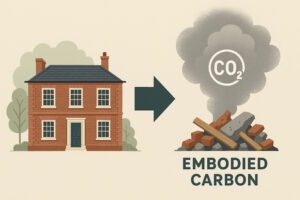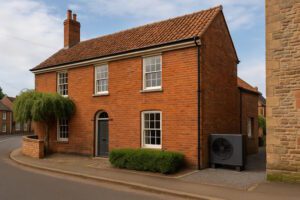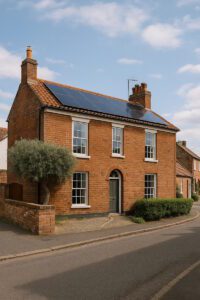Carbon Considerations in the Historic Built Environment
Balancing Retrofit, Reuse & Heritage Sensitivity in a Carbon-Conscious Age
As climate change escalates and the UK moves closer to its 2050 net zero target, increasing attention is being paid to the carbon footprint of the built environment. While the public discourse still often centres on energy-efficient new builds, there’s a growing understanding that retention and sensitive retrofit of existing buildings — including historic assets — may offer a more immediate and meaningful path to decarbonisation.
At AB Heritage, we see this shift not just as a technical challenge but as a crucial opportunity to align heritage practice with the UK’s decarbonisation agenda.
The Case for Retention: Embodied Carbon and Heritage Assets
Retaining existing buildings preserves their embodied carbon — the cumulative emissions from the original construction process, including material extraction, manufacturing, transport, and assembly. Demolishing a building releases this embedded carbon and generates additional emissions through waste processing, new materials, and construction activity.
 While operational carbon (emissions from heating, lighting, etc.) has traditionally been the focus of sustainability discussions, embodied carbon now accounts for over half the lifetime emissions of many buildings — and potentially more in high-performing homes.
While operational carbon (emissions from heating, lighting, etc.) has traditionally been the focus of sustainability discussions, embodied carbon now accounts for over half the lifetime emissions of many buildings — and potentially more in high-performing homes.
In this context, the reuse and adaptation of historic buildings is an environmental necessity. Many of these structures were built with robust, locally sourced materials and, when sensitively upgraded with measures such as draughtproofing, secondary glazing, and discreet insulation, can perform to high environmental standards.
Retrofit, Sensitively Done
Of course, retrofitting heritage assets brings particular constraints. Many are listed or lie within Conservation Areas, and even unlisted buildings may hold local significance or contribute meaningfully to a historic setting.
Any retrofit scheme should therefore prioritise minimal harm and maximum reversibility — enhancing thermal performance while respecting the building’s character and fabric. Poorly planned interventions can cause unintended issues such as trapped moisture, reduced ventilation, or harm to significance.
This is where heritage consultants and conservation-accredited professionals have a crucial role. By guiding schemes through careful assessment, supporting planning and consent applications, and championing practical solutions, we can help clients meet sustainability goals without undermining the value of the buildings themselves.
Heat Pumps in Historic Buildings: A Practical Option

Heating remains one of the most carbon-intensive aspects of building operation, especially in older buildings with gas or oil systems. Air Source Heat Pumps (ASHPs) provide a lower-carbon alternative — and growing evidence now supports their compatibility with heritage settings.
Historic England has published guidance explicitly stating that heat pumps can work in older buildings, including those without full fabric upgrades. Their recent position paper dispels several common myths — such as excessive noise, poor performance in cold weather, or high retrofit costs — noting that many of these concerns are outdated or exaggerated (Historic England, 2023).
Tailored, building-specific solutions remain key. As outlined in Installing Heat Pumps in Historic Buildings, factors like internal layout, heat loss, and existing heating systems must all be considered (Historic England, 2023). The guidance also highlights practical case studies where well-integrated ASHPs deliver good performance without compromising heritage values.
In short, heat pumps are a viable, even recommended, option in many historic settings — provided designs are sympathetic and supported by professional advice.
Policy Support and Shifting Practice

The idea that heritage and sustainability are in conflict is increasingly outdated. In truth, historic buildings can — and must — play a role in the UK’s net zero future.
UK planning policy increasingly supports low-carbon adaptation of the historic environment. The National Planning Policy Framework (NPPF) places significant emphasis on both heritage conservation and climate action. Planning Practice Guidance encourages councils to support low-carbon technologies where impacts can be mitigated.
Organisations such as Historic England and the Sustainable Traditional Buildings Alliance (STBA) are helping to lead this transition, with detailed guidance on sustainable upgrades for solid walls, roofs, windows, and mechanical systems.
As the regulatory and professional landscape evolves, the tools and knowledge to retrofit historic buildings are improving — making it easier to deliver both environmental and heritage gains.
Conclusion: Sustainability and Heritage — Not Mutually Exclusive
By retaining embodied carbon, upgrading existing buildings with care, and taking a pragmatic approach to technologies like heat pumps, the sector can lead by example. We can protect our built heritage while helping tackle the climate emergency — proving that our past doesn’t have to stand in the way of a greener future.
Want to talk more about carbon and heritage?
Whether you’re a developer, planner, architect, or homeowner, AB Heritage can provide expert advice on integrating historic sensitivity and carbon reduction from the earliest stages of your project.